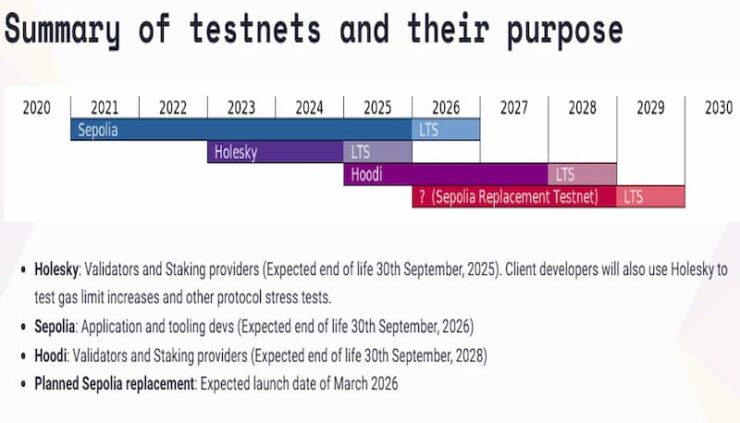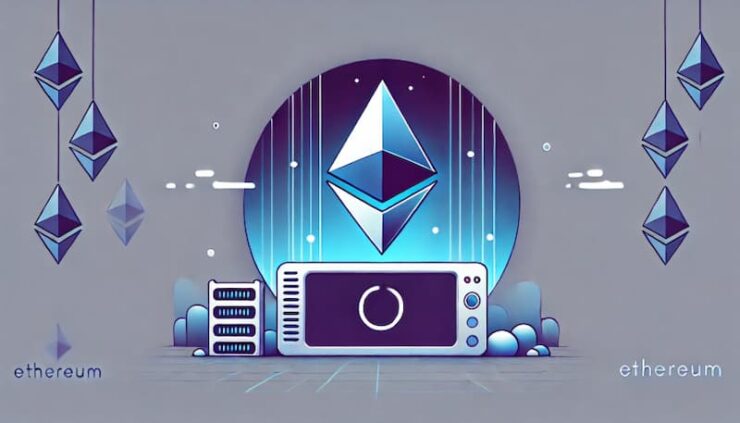Ethereum core developers are officially preparing to sunset the Holesky testnet by September 2025, marking the end of another critical testing environment as the network evolves toward its next major upgrade.
The decision comes amid persistent congestion issues on Holesky, limiting its functionality for essential community testing. As Ethereum pushes forward with ambitious plans like the Pectra upgrade, developers are now prioritizing a new environment—Hoodi testnet, to ensure testing keeps pace with mainnet development.
Launched in September 2023, Holesky quickly became a backbone for Ethereum’s staking, infrastructure, and protocol testing. It was designed to replace earlier testnets like Goerli, Kiln, Ropsten, and Rinkeby all of which were phased out as the Ethereum ecosystem matured.
However, Holesky hit a bottleneck during testing for Pectra, Ethereum’s upcoming hard fork. A congested validator exit queue rendered Holesky inefficient for further validator-related testing, forcing developers to reevaluate its utility.
According to the Ethereum Foundation, it could take nearly a year for all validators to exit Holesky’s queue a delay that would stall critical testing cycles.

Hoodi Testnet Takes Center Stage Ahead of Pectra Upgrade
To address the limitations, Ethereum developers launched the Hoodi testnet, set to activate the Pectra upgrade on March 26, well ahead of Pectra’s anticipated mainnet rollout in the second quarter of 2025.
Hoodi is now the preferred environment for staking operators and infrastructure providers conducting validator tests. The move ensures the community can rigorously trial Pectra’s new features without Holesky’s technical bottlenecks.
While Holesky will remain live for the short term, its role is shifting. Developers are considering repurposing it as a core developer testnet, a sandbox for gas limit experiments, stress tests, and other protocol-level development needs.
Ethereum’s roadmap has consistently favored agile upgrades, which includes retiring legacy testnets no longer fit for purpose. The Holesky deprecation mirrors past decisions to phase out Ropsten, Rinkeby, Kiln, and most recently, Goerli.
This approach reflects a maturing ecosystem where testnets serve more targeted roles rather than acting as general-purpose environments indefinitely.
By cycling through testnets, Ethereum developers aim to minimize technical debt, reduce infrastructure bloat, and ensure alignment with current and future protocol standards.
What This Means for Developers and the Ethereum Ecosystem
The Holesky shutdown underscores Ethereum’s growing pains as it balances rapid innovation with the need for reliable testing infrastructure. For developers, the message is clear, migrate validator testing to Hoodi and prepare for Holesky’s deprecation.
In the long term, this shift helps streamline Ethereum’s testnet landscape, ensuring smoother upgrades like Pectra and bolstering confidence in the network’s scalability and resilience.
With institutional adoption of Ethereum increasing and high-stakes upgrades like Danksharding on the horizon, robust testing environments are more critical than ever.
The Road Ahead
As Ethereum evolves, testnet turnover will likely continue to reflect the network’s commitment to adaptability and performance. Holesky’s deprecation is part of that evolution, clearing the path for new tools like Hoodi to support Ethereum’s next chapter.
For now, all eyes turn to the Pectra upgrade and how Hoodi will shape Ethereum’s testing future.





